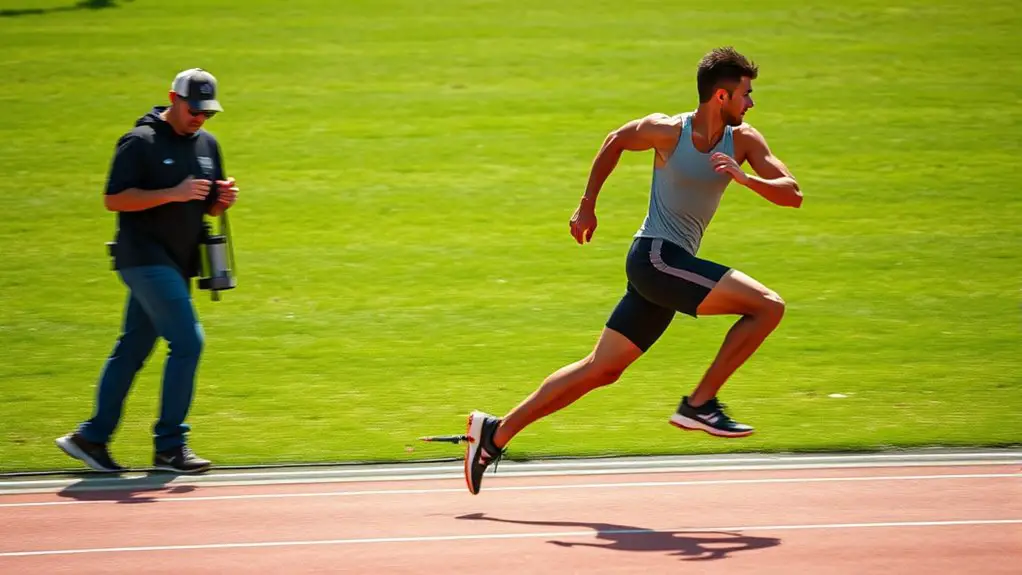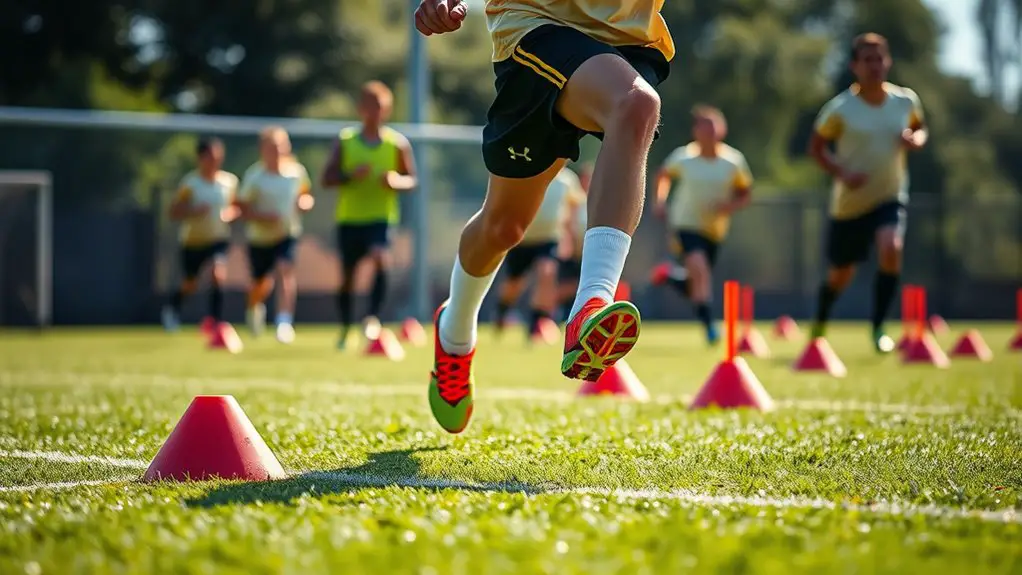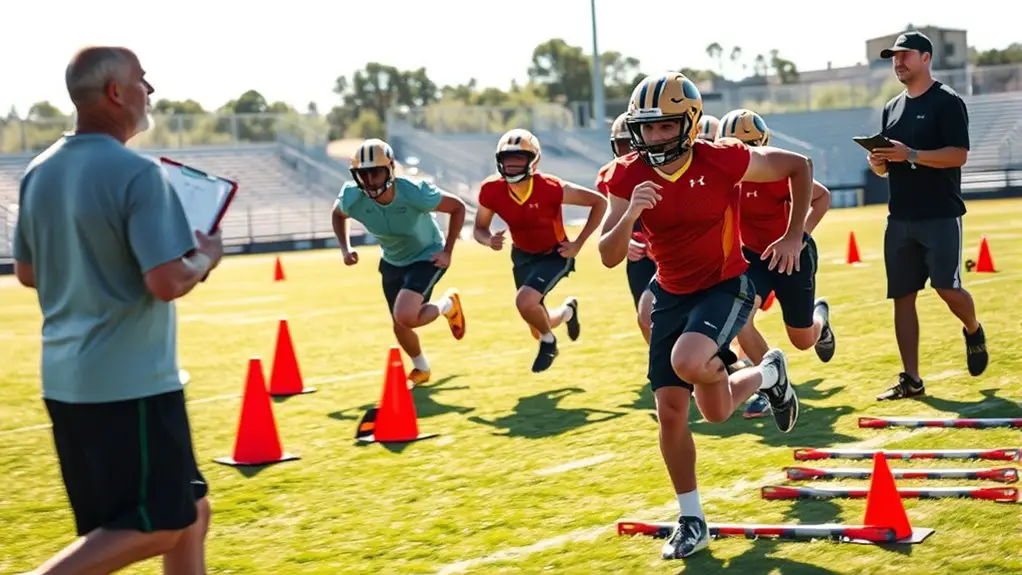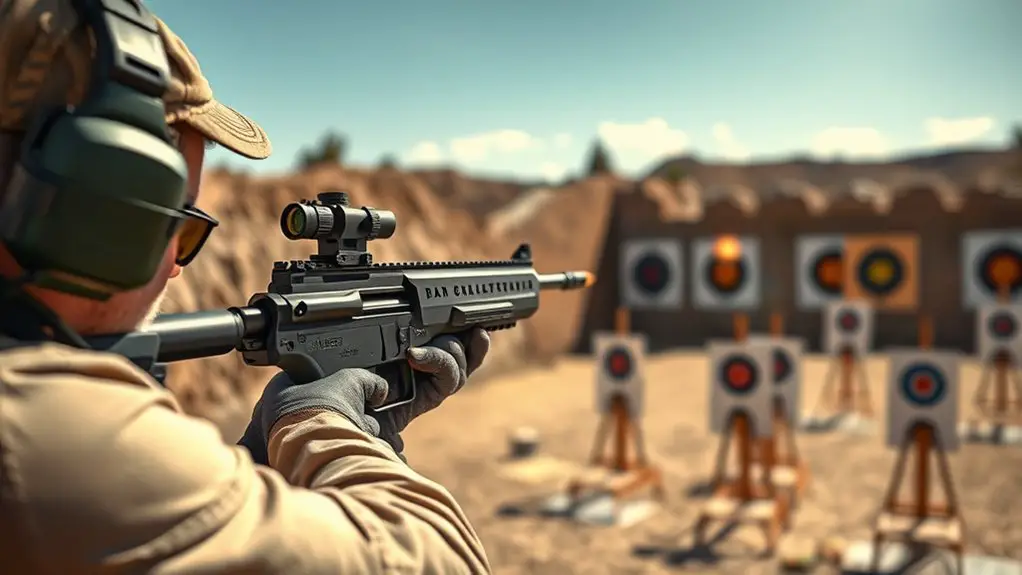To maximize your sprinting potential, focus on overspeed techniques like downhill running and using overspeed treadmills. These methods enhance speed and muscle conditioning while minimizing impact. Resisted sprints with bungee cords can boost explosiveness and coordination. Incorporate flying sprints for maximum velocity and plyometric drills to improve your explosive power. Remember, combining these techniques is key to seeing real improvements. Stick around to discover even more strategies that can take your sprinting to the next level.
Downhill Running Techniques
Downhill running can be a game-changer for sprinters looking to enhance their speed. When you run downhill, your body experiences a natural speed adaptation, pushing you to adapt to faster paces. This technique not only hones your downhill form but also conditions your muscles to handle increased effort without the usual strain.
As you lean slightly forward and let gravity do some of the work, you'll notice how your strides lengthen effortlessly. It's important to maintain control, though. Focus on keeping your core engaged and your feet landing lightly beneath you. Additionally, integrating strength training for runners can further improve your overall performance and stability while executing downhill runs.
Resisted Sprints With Parachutes
While you may be familiar with traditional sprinting drills, resisted sprints with parachutes offer a unique way to boost your explosive speed and power. By incorporating parachute resistance into your training, you can enhance your sprint mechanics and engage your muscles more intensely. As you sprint, the parachute creates drag, forcing you to push harder against the resistance. This not only builds strength but also improves your acceleration and top-end speed. To develop leg power effectively, consider integrating plyometric exercises alongside parachute sprints into your routine.
To get started, attach the parachute securely to your waist and find an open space. As you sprint, focus on maintaining proper form and driving your legs. The added resistance will help you develop a powerful stride, which translates into greater speed when the parachute's off. Remember, the key is to embrace the challenge and let the resistance inspire you to break free from your limits. With consistent practice, you'll discover newfound freedom in your sprinting abilities.
Use of Overspeed Treadmills
Overspeed treadmills are a powerful tool for sprinters looking to enhance their speed and improve their performance. These specialized machines allow you to run at speeds beyond your natural capabilities, pushing your limits in a controlled environment. By adjusting the treadmill speed settings, you can progressively increase the challenge, making each session a unique experience tailored to your goals.
One of the key overspeed treadmill benefits is the development of faster neural pathways, which helps you become more efficient in your sprinting mechanics. This training method also reduces the impact on your joints compared to outdoor sprints, giving you the freedom to train hard without worrying about injury. Additionally, incorporating interval training into your routine can lead to significant gains in speed, agility, and overall sprinting performance. So, embrace this technology and release your full potential on the track!
Sprinting With Bungee Cords
Sprinting with bungee cords can take your training to the next level by enhancing your speed and explosiveness. It's important to understand the benefits, proper techniques, and safety precautions involved in this method. Let's explore how to effectively integrate bungee training into your routine. Additionally, incorporating explosive power training can significantly improve the effectiveness of your bungee workouts.
Benefits of Bungee Training
When you incorporate bungee training into your sprinting routine, you can access a host of benefits that elevate your performance. The bungee resistance provides a unique challenge, allowing you to push your limits and enhance your speed development. You'll feel the exhilarating freedom of sprinting faster than ever, as the bungee cords help you achieve that over-speed sensation. This technique not only builds explosive power but also improves your stride efficiency and coordination. You'll find yourself breaking through barriers, gaining confidence, and revealing your true potential on the track. Embrace the thrill of bungee training, and watch as your sprinting transforms into a faster, more dynamic expression of freedom. It's time to release your speed!
Proper Technique Guidelines
To maximize the benefits of bungee training, focusing on proper technique is essential. Start by ensuring your body maintains proper form throughout the sprint. Keep your head up, shoulders relaxed, and arms pumping in rhythm with your legs. This alignment enhances your sprint mechanics, allowing for greater speed and efficiency. As you accelerate, concentrate on driving your knees high and landing on the balls of your feet for peak propulsion. Remember to engage your core, as it stabilizes your body and supports powerful strides. Finally, practice shifting from the bungee pull to your natural sprinting motion smoothly to maintain momentum. By honing these techniques, you'll reveal your potential and experience the exhilarating freedom that comes with faster sprints.
Safety Considerations and Precautions
Maintaining proper technique during bungee training is important, but safety should always come first. Before you even strap on that bungee cord, make sure you follow thorough warm-up protocols. This'll help get your muscles primed and reduce the risk of injury. As you sprint, keep your awareness high; the elastic tension can be unpredictable. Always use a spotter or coach to monitor your form and provide support. Consider starting with lighter resistance to gauge your body's response. Remember, pushing your limits is essential, but injury prevention should always be your priority. Listen to your body, and if something feels off, be ready to stop. Freedom in sprinting comes with responsibility—stay safe and enjoy the rush!
Plyometric Drills for Speed Enhancement
Plyometric drills can greatly boost your sprinting speed by enhancing explosive power. Box jumps and depth jumps improve your strength and reactive ability, while bounding for distance helps you develop your stride length. Additionally, incorporating these drills leads to increased power through the development of fast-twitch muscle fibers, which can significantly enhance your performance on the track.
Box Jumps Benefits
Box jumps are an explosive exercise that can greatly enhance a sprinter's speed and power. By incorporating box jump variations into your training routine, you'll not only build strength but also improve your explosive power, which is vital for sprinting. These dynamic movements engage your fast-twitch muscle fibers, helping you develop the quickness needed to take off from the starting blocks. Plus, they promote better coordination and balance, making your strides more efficient. You can mix things up with different heights and jump styles to keep your workouts fresh and exciting. Embrace the challenge, and you'll notice significant improvements in your sprinting performance, giving you the freedom to push your limits and reach new heights.
Depth Jumps Technique
Depth jumps are often overlooked in sprint training, but they can be a game-changer for enhancing speed. By utilizing gravity to your advantage, you'll tap into explosive muscle activation, which can greatly boost your sprint performance. Start with a controlled height, focusing on landing softly to maximize depth jump benefits. As you grow more comfortable, you can progress to higher platforms, incorporating depth jump progression into your routine. This gradual increase not only builds strength but also improves your overall coordination and power output. Remember, it's all about quality over quantity—prioritize proper form to avoid injury. With consistent practice, you'll find that your speed and agility will improve, giving you the freedom to push your limits.
Bounding for Distance
Building on the explosive power gained from depth jumps, incorporating bounding for distance into your training regimen can further enhance your sprinting capabilities. These bounding techniques focus on maximizing your stride length and improving your ground contact time, ultimately translating to faster sprints. By embracing distance training, you'll develop strength and power in your legs while honing your coordination and rhythm.
Start with low-intensity bounds, gradually increasing the distance and speed as you progress. Aim for a smooth, flowing motion, feeling the freedom in your stride. Incorporating bounding drills not only enhances your performance but also keeps your workouts engaging and enjoyable. Remember, it's about feeling the exhilaration of speed while building the foundation for explosive sprinting.
Flying Sprints for Maximum Velocity
While many sprinting drills focus on acceleration, flying sprints are vital for developing maximum velocity. These drills allow you to hit higher speeds without the initial buildup, giving you a taste of pure freedom on the track. To execute flying sprints, start with a 20-30 meter flying start, gradually building your speed before entering your full sprint. This technique helps you emphasize speed maintenance, important for racing success.
Incorporating flying sprints into your routine can elevate your performance. They improve your stride length and frequency, helping you find that sweet spot where you feel unstoppable. Aim for 4-6 repetitions, ensuring you recover fully between sprints. As you master these drills, you'll notice a significant boost in your top-end speed, allowing you to break through barriers and experience the exhilarating rush of running at maximum velocity. Additionally, combining flying sprints with acceleration drills enhances your overall speed development and racing efficiency. Embrace flying sprints and redefine your limits!
Incorporating Hill Sprints Into Training
Hill sprints are a powerful addition to any sprinter's training regimen. They offer a unique opportunity to boost your speed and strength while minimizing the risk of injury. By incorporating hill sprinting benefits into your routine, you'll engage different muscle groups and improve your explosive power.
To get started, find a hill with a moderate incline. Focus on proper hill sprinting techniques: drive your knees high, pump your arms vigorously, and keep your core engaged. Begin with shorter distances, gradually increasing as you become more comfortable.
Aim for 6-10 sprints per session, allowing ample recovery between each run. This will help you maintain form and maximize speed. Make hill sprints a regular part of your training, and you'll soon notice improved acceleration and endurance. Additionally, hill sprints engage fast-twitch muscle fibers, which are essential for developing explosive speed. Embrace the challenge; it's an exhilarating way to push your limits and release your true potential as a sprinter!
Frequently Asked Questions
How Often Should I Incorporate Overspeed Training Into My Routine?
When considering how often to incorporate overspeed training into your routine, aim for about once or twice a week. This training frequency allows you to push your limits while still providing adequate recovery periods for your muscles. It's all about finding a balance that fits your lifestyle and goals. Listen to your body, and adjust as needed to guarantee you're not overdoing it. Enjoy the freedom to train at your own pace!
What Are the Benefits of Overspeed Training for Sprinters?
Imagine blasting past your limits like a cheetah on caffeine! That's the thrill of overspeed training for you. It sharpens your speed mechanics, fine-tuning your form and efficiency. By pushing you beyond your usual pace, you'll experience incredible neuromuscular adaptation, making your muscles fire faster and more effectively. You'll feel the freedom in your stride, allowing you to release your full potential on the track. Get ready to fly!
Can Overspeed Training Prevent Injuries in Sprinters?
Yes, overspeed training can contribute to injury prevention for sprinters. By enhancing your neuromuscular coordination and improving your running mechanics, you're less likely to suffer from common injuries. Incorporating these training techniques helps your body adapt to faster speeds, promoting strength and flexibility. Just remember, while overspeed training is beneficial, it's crucial to balance it with proper recovery to guarantee your body stays resilient and ready for the track.
What Age Is Appropriate to Start Overspeed Training?
When it comes to starting overspeed training, age considerations are essential. Generally, you should wait until you're around 15 or older, as that's when your body's more developed and ready for the demands. It's not just about age; training readiness matters too. You've gotta guarantee you've built a solid foundation in sprinting techniques and strength. Rushing into it can lead to injuries, so embrace the process and listen to your body!
How Do I Track Progress With Overspeed Training Techniques?
Tracking your progress with overspeed training is like charting your own flight through the skies. You'll want to establish clear progress metrics, such as speed, reaction time, and endurance. Use performance analysis tools like video recordings or timing systems to visualize your improvements. Regularly compare your results to previous sessions, and don't forget to celebrate those small victories. Freedom in your performance comes from knowing where you've been and where you're soaring to next!




